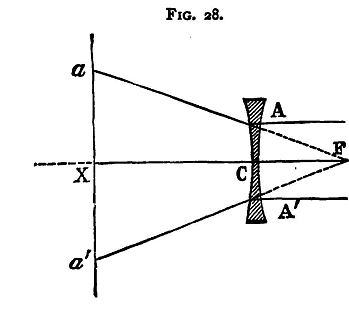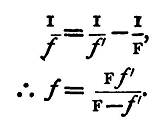| Practical Physics is a free textbook on basic laboratory physics. See the editorial for more information.... |

|

Home  Mirrors and Lenses Mirrors and Lenses  Measurement of the Focal Length of a Concave Lens Measurement of the Focal Length of a Concave Lens |
|






|
|
Measurement of the Focal Length of a Concave Lens
Method 1 (requiring a more or less darkened room):
Place in front of trie lens a piece of black paper with two narrow slits A, A' cut parallel to each other at a known distance apart, and let light which is quite or nearly parallel fall on the lens (fig. 28). Two bright patches will be formed on a screen at a, a', by the light passing through the two slits, and the rays forming them will be in the same directions as if they came from the principal focus F of the lens. If then we measure a a' and CX, and if CF = f we have
from which f can be found The distance, between the centres of the bright patches can be measured with a pair of compasses and a finely divided scale, or by using a scale as the screen on which the light falls. In consequence of the indistinctness of the bright patches, this is only a very rough method of determining the focal length. Method 2: The second method consists in placing in contact with the given concave lens a convex lens sufficiently powerful to make a combination equivalent to a convex lens. Let the focal length (numerical) of the concave lens be f, that of the auxiliary convex lens f', and that of the combination F. Then
The values of F and f' can be found by one of the methods described for convex lenses. In selecting a lens with which to form the combination it should be noticed that, if F and f' differ only slightly, say by 1 centimetre, an error of 1 millimetre in the determination of each, unless the errors happen to be in the same direction, will make a difference of one-fifth in the result The auxiliary lens should therefore be chosen to make the difference F-f' as large as possible - i.e. the concave lens should with the convex produce a combination nearly equivalent to a lens with parallel faces, so that 1/f may be very nearly equal to 1/f'. For greater accuracy the light used should be allowed to pass through a plate of coloured glass, so as to render it more nearly homogeneous. Experiment. - Determine by the two methods the focal length of the given lens. Enter results thus: Lens D. Method 1: Distance between slits: 2.55 cm Distance between images: 4.75 cm Distance from lens to screen: 33.00 cm Focal length: 38.24 cm Method 2 Focal length of convex lens: 29.11 cm Focal length of combination: 116.14 cm Focal length required: 38.85 cm
|
|
Home  Mirrors and Lenses Mirrors and Lenses  Measurement of the Focal Length of a Concave Lens Measurement of the Focal Length of a Concave Lens |
|
Last Update: 2011-03-15




